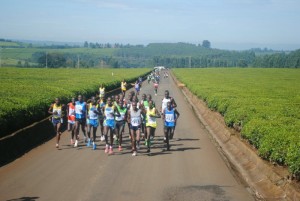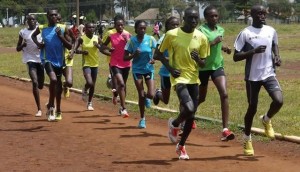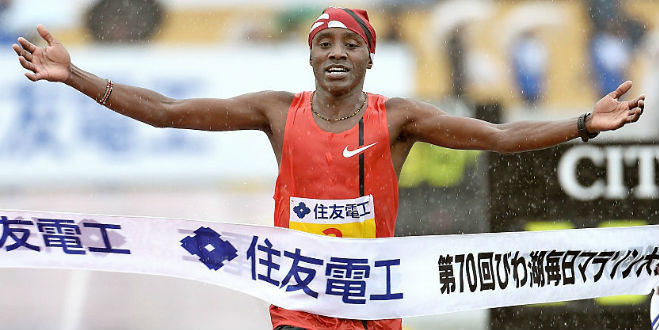If you want to run better, run further, run easier or recover faster you need to know what to do to achieve this. You need to know the factors that would affect your performance and how you can work on them if possible since some can easily be dealt with, while others such as age may be out of control. Chances are there are areas of your life that you hadn’t thought are important. If you thought you had done all you could to run as fast as possible read on, then you will have a second thought. Below is Stephen Ndungu’s list:
AGE:
Unfortunately there is not a lot you can do with this. But recognizing what happens to your body due to the passing of time will help you plan your training and not make adjustment that are counter productive. Stephen said ”the first couple of years of training improvement is guaranteed. ”Then you will come to a point where performance will start to decline. It is important to know and accept that as there is nothing more disappointing than when you seem to be working harder than ever with no improvement and even struggling to maintain your performance. You take longer to recover too. The biggest reason for this is the function of the heart, which looses its elasticity as a person grows.” This makes it harder to be able to run as fast as before as one grows older. More and more training is not the answer, as this may lead to a breakdown.
GENETICS:
Genetics is another factor that one cannot change. Accepting what nature has given you, makes it easier to play to your strengths and work on your weaknesses. Stephen said ‘Genetics is about the type of body you have. And it also governs the type of person you are to some extent. ”You can change your body and mind with training. But some people are always going to be able to be better than others. Muscles’ fibers are surrounded by blood capillaries. Kenyans like me have six to eight around them, while Westerners only have four around them.The ability to supply blood to the muscles is one of the most important training

adaption you are trying to make. So all other things being equal a Kenyan runner will be better.” But if you train your body will improve its ability to supply blood to the muscle and make up for those genetic differences. Stephen continued: ”Another genetic factor is the type of muscle fiber you have – fast twitch or slow twitch. ”Someone like Usain Bolt would have a fast twitch to slow twitch ratio of 90:10. A marathon runner has more slow twitch. Fast twitch, slow twitch. It is not a question of good or bad. It`s more about what distance you are likely to be the best at, and working on getting the muscle fibers you do have into the best possible shape.
TRAINABILITY:
Stephen explained: If you give two people the same training program they will benefit at different rates. If you got them to do each other program perhaps they would run five seconds slower or get injured. It is to do with the way your body is made- you can’t control that.”So don’t be disillusioned if someone else seem to improve faster than you. It may be that they respond better to training than you or it may be you will catch them up over time as improvement is rarely at constant rate. And don’t be tempted to just copy another person’s schedule just as it seems to work for them. Keep a training diary to see what training you run best off and what causes your injuries or staleness and learn from it. Everyone is unique.
CLIMATE:
Its official. You can blame it on the weather. Stephen revealed: When you are running 70% to 80% of your energy is being turned into body heat. The longer you have been training the less your body deteriorates in a two week break.
FLEXIBILITY:
This is an area that distance runners too often neglect. Stephen Ndungu said: ” You can improve the range of movement of the joint and your performance. By stretching you are also likely to be able to recover better and are less likely to pick up strains and injuries. Doing some stretching to warm up before training has some benefits. To develop flexibility the best time to stretch is after training. You should stretch to a position of moderate discomfort. You should do a 20 to 30 second stretch two or three times. This is because the muscles have a stretch reflex. If you stretch a muscle it reacts by retracting a bit – this is designed to stop it over stretching. This reflex doesn’t relax for eight seconds so if you do a ten second stretch you are effectively only holding it for two seconds which will not be doing much good at all.
TECHNIQUE:

Stephen said: ” You should have everything in line with the direction you are running. Sprinters spend hours doing drills to improve their techniques. For example they try to lift their knee with their toes pointing upwards rather than pointing out straight. Which creates a shorter lever so it is less hard work to bring the leg through. If it is important to a sprinter it must be even more important to an endurance athlete who has to run further.
BIOMECHANICS:
Choose your footwear carefully as this is your most important piece of kit . As a Sport Science student Stephen , explained: ” Biomechanics are used by shoe manufactures to fine-tune how they make shoes. They get camera looking at how the foot lands and see what is typical then develop shoes that suit different types of people. ”It is important that you wear the right type of shoe. If you struggle a lot then you may need to get orthotics to modify your techniques”
TACTICS AND STRATEGY:
When you race don’t just run harder, run smarter. This way you will get more for your effort. Stephen Ndungu told us: ” At 67 seconds per 400m lap you are moving at six meters per second. At this speed 8% of your energy is going into overcoming air resistance. If you can tuck in behind someone you can save 80% of that 8%. So that is 6% of your effort. That is why when you see athletes going for a record they get a pacemaker. It is not because they can’t judge the pace – they probably judge it better than anyone else- but they are using the pacemaker to give them shelter. ” You should also try to run at an even pace. It is easy to go out too fast, particularly if there is someone around whom you don’t want to be overtaken by. Run your own race you can’t control other people.”
LIFESTYLE:
Everything you do has an impact on your needs to be kept within a very narrow temperature range. If you go too far above the optimal temperature your performance declines. If you are too cold your performance also goes down as your muscles are too cold and some systems shut down as well. You can`t control the weather but this means you should pay all the more attention to the next point.
CLOTHING:
Stephen Ndungu advised: ” In hot weather wear clothing that helps you get rid of heat. “On the other side of things when it is cold – particularly in the wet – you need to keep warm and dry. This is particularly important on long runs. If you are too cold you lose heat very quickly . You must wear fabrics which keep you dry and warm. So all that state of the art kit is not a fashion accessory. Get stocked up with the technical fabrics suitable for all weather conditions.
NUTRITION:
“People tend to focus on carbohydrates but nutrition is very simple,” said Stephen. “If you are training hard and regularly you can’t eat too much. You are burning a lot of calories and need to replace them. It is an important factor- if you run on a half empty tank then you are not going to perform. Your muscles are most receptive to replenishing within 30 minutes of finishing training and racing. Eat 50g of carbohydrate, probably four to five Jaffa cakes, within 30 minutes of training then in the two hours after eat another 250g of carbohydrate. If you leave it too long the muscles then become less receptive to taking in the carbohydrate. In Kenya according to Stephen all athletes eat ugali [ maize meal prepared with hot water] and vegetables. “If you have a sensible balanced diet you don’t need supplements. Runners need 60% to 70% carbohydrate and four to five pieces of fruit and vegetables each day.”
FLUID:
This was one area Stephen stressed most people, professional sports people included, could do much better on: “You need to keep well hydrated. With anything over 5km fluid is important. People don’t normally have enough fluids on board to start exercise. A little and often all the time is the key – a cup of water every 20 to 30 minutes.
Generally water is fine but if you are in hot climate the challenge is to get fluid in more quickly.You need something to help speed up the absorbing and retaining of that water. You sometimes see athletes with a 1.5 liter bottle of water and just before the training they drink it down. They then excrete most of it and absorb hardly any of it. “Drinking on the run is difficult so you need to practice that. During training drink the same amount you will drink on the race day.
PHYSIOLOGY:
You physical state is going to affect your performance but you can’t just use one indicator as a die hard predictor of performance: “There are indicators such as V02 max. It is an index that relates to stamina or aerobics fitness. A good runner can take in and utilize lots of oxygen when they are running. If you look at 10km times and VO2 max readings of people those with higher VO2 maxes will have better 10km times. But if you take a narrow band of performance at 10km and look at their V02 maxes they will be all over the place. In general VO2 max affects performance but many other factors come into play –such as running economy.
ENDURANCE TRAINING:
An area that most runners do pay a fair bit of attention . Stephen said : “This affects running economy and your V02 max. You should do different runs at different intensities for the best training effect and good results .”
STRENGTH:
This area is too often neglected. Stephen said: “This is very important as it is one of the factors that long distance runners often ignore. They think, ” If I just run all the time it will be fine.’ “The biggest arguments in favour of strength training is to decrease the risk of injury. But also, if you can increase your stride length and can take a stride half an inch longer over 15km that is a big factor. “You can do resistance running such as hill training. Try not to run on too steep gradients or your style of running will vary and you will run with a different technique. Hill training will strength the muscles you use when running. “Or you can go to the gym. This is useful for strengthening and toning the muscle and reducing the risk of injury. Perhaps the most important thing is improving the muscles of posture. A weak lower back often leads to hamstring problems. By training the muscles of posture you improve the performance and reduce the risk of injury.”
TRAINING HISTORY:
This is all about experience which is the best teacher. Experience does count for more than knowledge and being able to to tell how you once pulled clear for a magnificent victory in major event . If you ever wanted an incentive to keep going with the training even when things get tough it is this. “The longer you have been training the better you will be able to perform –until age. So train hard and stay focused, and always remember that ” If you want to be the best you must train with the best ” .
Hits: 343
 Mt. Kenya Talents Development Centre Mt. Kenya Talents Development Centre
Mt. Kenya Talents Development Centre Mt. Kenya Talents Development Centre





